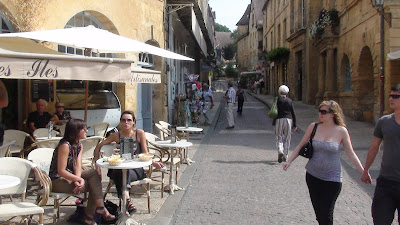Friday, September 16th
This morning the four of us drove to Sarlat, 10 km east of Beynac. We headed for the old town, always the most interesting part of any village or town in the Dordogne. Sarlat is the capital city of this part of the Dordogne, its history stretching back well over a thousand years.
Like many other towns in this region, its location close to the border between the opposing English and French during The Hundred Years War (actually a 116 year series of conflicts between 1337 and 1453) meant that it changed possession a number of times.
We parked near the town center, and walked the narrow streets to the old town square. Off to one side was a life size bronze sculpture of three geese, in honor of the region's reputation for excellent pate foi gras.
Then it was back along forested roads the short distance to the village of La Roque Gageac where we enjoyed a picnic lunch of crusty french bread, cheese, and a bit of wine.
As in Beynac, in La Roque Gageac there are modern versions of the old flat bottomed boats called"gabares", available for sightseeing rides on the Dordogne River.
Mirm and BT cruised off upstream on one of these boats while we climbed the steep village streets, ascending toward the stairs that led to old dwellings visible high on the cliffs above the town.
 The west-facing cliffs soak up heat from the afternoon sun, gradually releasing it again late into the evenings, creating an almost tropical sub-climate for this riverside village, and we noticed abundant bougainvillea, colocasia with their big elephant ear leaves, banana plants, bamboo, and various kinds of palm trees all growing in healthy profusion.
The west-facing cliffs soak up heat from the afternoon sun, gradually releasing it again late into the evenings, creating an almost tropical sub-climate for this riverside village, and we noticed abundant bougainvillea, colocasia with their big elephant ear leaves, banana plants, bamboo, and various kinds of palm trees all growing in healthy profusion. We were disappointed when we arrived at the upper end of the street to find a wire mesh barrier blocking access to the stairs up to the troglodyte refuges up on the cliff. In 2010 a big section of the cliff had broken away, destroying several houses. Not long after, part of one of the old masonry walls high up had also fallen through the roof of another house.
After the rock falls, heavy cable netting, supported by large steel I-beams had been erected at the base of the cliff above the village to protect residents from any more falling rocks, and it appears that the cliff-dwellings will not be re-opened any time in the foreseeable future.
After the rock falls, heavy cable netting, supported by large steel I-beams had been erected at the base of the cliff above the village to protect residents from any more falling rocks, and it appears that the cliff-dwellings will not be re-opened any time in the foreseeable future.
The view across the river and the valley was worth the climb, however, and we walked back down via a different path, arriving back at the landing just as the gabarre was tying up at the boat landing.
Since this was our last evening staying in Beynac, we joined everyone in our travel group for dinner at the hotel restaurant for a delicious 4 course dinner on the terrace.





No comments:
Post a Comment